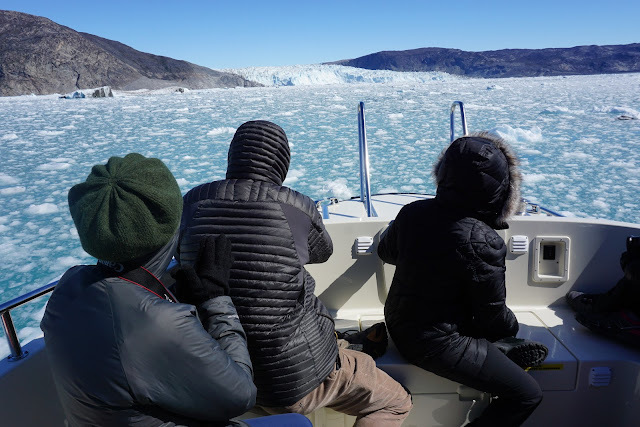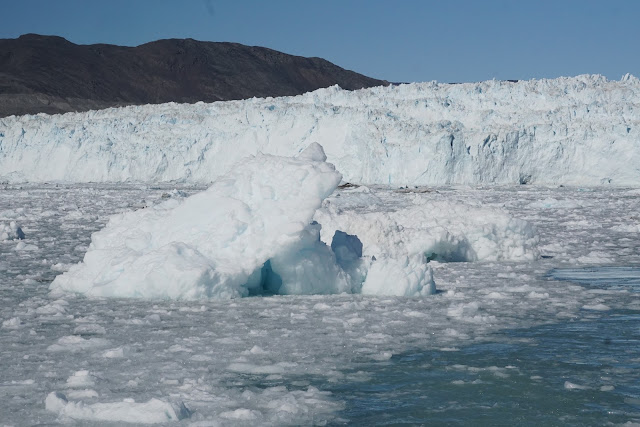June 16, 2019
At 11:00 AM--an unusually but very welcome late start for our group--we left for one more boat trip, a six- or seven-hour cruise to the Eqi Glacier, known for its vast breadth and frequent calving.
Along the way several members of our group sang versions of the "Theme from Gilligan's Island," and I was introduced to this marvelously campy mash-up version entitled "Stairway to Gilligan's Island." Just think "Arctic isle" instead of "desert isle":
This map shows our course, starting in Ilulissat at the bottom of the map and motoring north through the Ataa Strait to the Eqi Glacier, a distance of about 50 miles:
It took about 1 1/2 hours to get to the glacier, but we did stop along the way at a beautiful waterfall. Note the glassy surface of the sea. The stillness was interrupted only by our own movements and voices and the musical acoustics of the waterfall:
Our guide hopped out of the boat and onto the lower rocks to fill a bottle with water from the falls.

At times it felt like we were pushing through the surface of a slushy punch bowl:
Instead of foamy sherbet, however, these were chunks of super dense, very hard ice, and they clunk-clunked against the side of the boat hard enough to make me a little nervous. I assumed that the hull was reinforced against possible puncture, but then, so was the Titanic, right?
Then the chunks became more of a sheet that appeared to be solid . . . but wasn't. In winter, however, when temperatures drop well below 0° F, the sea does freeze over, and this journey is impossible, at least for tourists like us.
It was bone-chillingly cold. Nevertheless, we were all on the forward deck with our cameras:
As we got our first sighting of the Eqi Glacier, the ice seemed to part to allow us to move closer:
"Eqi" means "edge," and as we came closer to the glacier, we felt like travelers to the edge of the world. There was no cell reception, and hadn't been for some time, and there were no other boats, no indication that human life exists at all. (Later on we did see one other small boat.) Just as it was earlier, it was eerily quiet other than the lapping of the sea against our boat and our own exclamations of wonder.
The size of the glacier is hard to convey in photos, but it is as much as 800 feet tall, or about 57 stories, and almost 2.5 miles wide, which is so long that it took three photos to capture it all. The photo above is of the left side, the one below is of the center . . .
. . . and this one is of the right end:
This panoramic shot includes most of it:
Our captain found a good place to park the boat about a mile away from the glacier, and we spent the next few hours in this surreal environment.
During that time, the crew set out quite an extensive spread for us that included breads and sandwich meats and lots of embellishments and sides. We did have to pay for our sodas, however, which cost a steep $6 each.
The Eqi Glacier's nickname is "The Calving Glacier" because it sheds a chunk of itself every 15 to 30 minutes, at least on sunny days such as the day we were there, making it one of the most active glaciers in Greenland. It was difficult to capture the calving in a photo because at a mile away we always SAW the event before we HEARD the explosive sound of the ice breaking off and crashing into the sea. As a result, I usually caught the tail end of the calving in my photos. Here are a couple of pictures where you can see what looks like a small-ish, smoky explosion near the water.
It might not look like much, but remember that the glacier is almost 60 stories tall:
Now it is obvious why our boat didn't get any closer to the glacier:
Each one of these "dumps" caused waves strong enough to rock our boat parked almost a mile away. We didn't see any exceptionally large chunks break loose, but supposedly they can cause tidal wave-sized disturbances in the water.
One of the results of the calving is large chunks of ice (aka icebergs) floating in the water:
In some places along the 2.5 mile stretch, the waves had carried many of the small chunks of ice away from the glacier, creating seaglass for narcissistic Eqi to admire himself in:

It was definitely cold, but note that in this photo none of us were wearing gloves. If the boat was moving, however, we put them back on.
And here the globe shows the entire glacier:
Here is another series covering the years 2011-2015, and even in that short time period, many changes are obvious. Climate change was a topic of discussion and obvious concern everywhere we went in both Iceland and Greenland:
Here is my photo of the right end of the glacier. In 1929, and perhaps even in 1953, the rock in this picture was under the glacier, and in 2013 the glacier extended far out into the sea. Now the glacier looks like a Native American tepee encampment clinging to the bank:
For two or three hours we were privileged to sit near this icy temple:
In other places, the glacier was clearly ice, not rock:
All good things must come to an end, and eventually our captain turned the boat around and we started on our journey back to Ilulissat:
Our guide pointed out what has to be the most remote hotel I've ever seen, the Glacier Lodge Eqi. Fifteen lodges and a community house offer wealthy guests the ultimate view of the glacier across a small fjord:
Here's a zoomed-in view. It looks quite nice:
There are even stairs down to the sea, which is not exactly the equivalent of hot springs or a nice swimming pool, but if you want to swim laps, there it is:
It was yet another wonderful, unique day in a string of such days, and we were relaxed and hungry when we got back to our hotel:
At 11:00 AM--an unusually but very welcome late start for our group--we left for one more boat trip, a six- or seven-hour cruise to the Eqi Glacier, known for its vast breadth and frequent calving.
Along the way several members of our group sang versions of the "Theme from Gilligan's Island," and I was introduced to this marvelously campy mash-up version entitled "Stairway to Gilligan's Island." Just think "Arctic isle" instead of "desert isle":
Our boat was a bit smaller than Gilligan's, but it definitely had the Gilligan vibe:
This map shows our course, starting in Ilulissat at the bottom of the map and motoring north through the Ataa Strait to the Eqi Glacier, a distance of about 50 miles:
There was a significant amount of water pouring over the top:
As it hit the horizontal surface, the water spread out like a lacy bridal train:
Our guide hopped out of the boat and onto the lower rocks to fill a bottle with water from the falls.

She told us that it was some of the purest water on the planet. It was refreshingly polar-cold.
Back in the channel, we began to see more and more chunks of ice floating like rubber duckies all around us:
There were also plenty of these majestic blue cathedrals to carefully steer around:
Instead of foamy sherbet, however, these were chunks of super dense, very hard ice, and they clunk-clunked against the side of the boat hard enough to make me a little nervous. I assumed that the hull was reinforced against possible puncture, but then, so was the Titanic, right?
Then the chunks became more of a sheet that appeared to be solid . . . but wasn't. In winter, however, when temperatures drop well below 0° F, the sea does freeze over, and this journey is impossible, at least for tourists like us.
As we got our first sighting of the Eqi Glacier, the ice seemed to part to allow us to move closer:
The size of the glacier is hard to convey in photos, but it is as much as 800 feet tall, or about 57 stories, and almost 2.5 miles wide, which is so long that it took three photos to capture it all. The photo above is of the left side, the one below is of the center . . .
. . . and this one is of the right end:
This panoramic shot includes most of it:
Our captain found a good place to park the boat about a mile away from the glacier, and we spent the next few hours in this surreal environment.
During that time, the crew set out quite an extensive spread for us that included breads and sandwich meats and lots of embellishments and sides. We did have to pay for our sodas, however, which cost a steep $6 each.
Bob is the king of the Dagwood sandwich:
And oh, the VIEW! The captain occasionally moved the boat to a different spot along the glacial front to give us a different perspective.
It might not look like much, but remember that the glacier is almost 60 stories tall:
Now it is obvious why our boat didn't get any closer to the glacier:
One of the results of the calving is large chunks of ice (aka icebergs) floating in the water:

It was definitely cold, but note that in this photo none of us were wearing gloves. If the boat was moving, however, we put them back on.
Our guide placed this grapefruit-sized glass ball on the stern. It flipped the view, putting the sea on top, an upside-down glacier in the center, and the sky on the bottom. We had fun playing with it. Here, one end of the glacier is visible:
And here the globe shows the entire glacier:
Our guide also had some interesting photos of Eqi Glacier dated 1912, 1929, 1953, and 2015. The dramatic recession of the glacier is clearly visible:
Here is another series covering the years 2011-2015, and even in that short time period, many changes are obvious. Climate change was a topic of discussion and obvious concern everywhere we went in both Iceland and Greenland:
For two or three hours we were privileged to sit near this icy temple:
In some places, Eqi's sheer cliffs even looked like marble:
Nature has a way of replicating herself in various forms and climates. Compare Greenland's Eqi Glacier (above) to England's White Cliffs of Dover (below):In other places, the glacier was clearly ice, not rock:
All good things must come to an end, and eventually our captain turned the boat around and we started on our journey back to Ilulissat:
Here's a zoomed-in view. It looks quite nice:
There are even stairs down to the sea, which is not exactly the equivalent of hot springs or a nice swimming pool, but if you want to swim laps, there it is:
It was yet another wonderful, unique day in a string of such days, and we were relaxed and hungry when we got back to our hotel:
















































One of the highlights of the trip (and of my life)was the approach to the glacier in the boat, the ice constantly hitting the bow. Mind blowing. The most remote place we've ever been and may ever be.
ReplyDeleteEnjoyed reading about this, and can only imagine the sounds (or lack of).
ReplyDelete